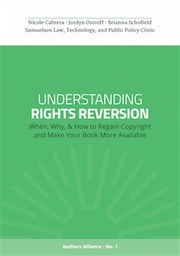
Nicole Cabrera, Jordyn Ostroff, Brianna Schofield, and the Samuelson Law, Technology and Public Policy Clinic. Understanding Rights Reversion: When, Why & How to Regain Copyright and Make Your Book More Available (Berkeley: Authors Alliance, 2015).
Although I am familiar with copyright and licensing agreements for journal articles, I am less familiar with book publishing agreements. Rights reversion for books was a new concept to me, so the first guide published by the Authors Alliance had my attention right away (the group has since published a second guide, Understanding Open Access). This guide is intended for authors who, for whatever reason, may wish to reclaim rights to their books– rights that they transferred to their publishers when they signed a publishing agreement. It’s the result of “extensive interviews with authors, publishers, and literary agents who shared their perspectives on reverting rights, the author-publisher relationship, and keeping books available in today’s publishing environment.” The guide follows an “if-then” organization, referring readers to specific chapters depending on their situation, though I read it straight through (full disclosure: I’m an Authors Alliance supporter).
Early on, the authors define rights reversion and its availability:
“a right of reversion is a contractual provision that permits an author to regain some or all of the rights in her book from her publisher when the conditions specified in the provision are met… in practice, an author may be able to obtain a reversion of rights even if she has not met the conditions stipulated in her contract or does not have a reversion clause.” (p. 6-7)
This guide is intended for authors with publishing agreements already in place; it is not a guide to negotiating contracts (though it may inspire authors to examine the details of rights reversion clauses in new contracts).
The authors note that rights reversion becomes an issue for academic authors especially when their books fall out of print, sales drop, or their publishers stop marketing their books. In such instances, authors may wish to reclaim their rights (so that they can find another publisher to reissue the book or perhaps deposit the book in an open access online repository) but they find themselves constrained by the terms of their publishing agreements or they may not understand how how to go about reclaiming their rights. With these concerns in mind, the Authors Alliance “created this guide to help authors regain rights from their publishers or otherwise get the permission they need to make their books available in the ways they want.”
An important first step in the process is for authors to learn about different ways that they might increase their books’ availability (for example, electronic, audio, and braille versions as well as translations). Next, the guide helps authors determine if they have transferred to their publishers the rights necessary to make their books available in the ways they want. Older contracts may be ambiguous regarding e-book versions; the guide advises authors on how to negotiate the ambiguity. An additional consideration is that permissions for usage of third-party content may no longer be in effect.
Some examples of reversion clauses are provided in chapter 4, pointing out triggering conditions (such as out of print, sales below a certain threshold, or a term of years), written notice requirements, and timelines. It’s important to understand how the triggering conditions are defined, as well as how to determine whether they have been met, and the authors provide good suggestions for finding this information.
The publisher’s plans for the book should be discovered, and the guide emphasizes reasonable, professional conversations with publishers. The success stories throughout the book are particularly valuable in this respect.
Chapter 6 details how to proceed if a book contract does not include a rights reversion clause:
“Ultimately, whether a publisher decides to revert rights typically depends on the book’s age, sales, revenue, and market size, as well as the publisher’s relationship with the author and the manner in which the author presents his request.” (p. 77)
Before requesting reversion, an author should have a plan in place, review all royalty statements, and discover the publisher’s plans for the book. Being reasonable, flexible, creative, and persistent are the golden rules for negotations with a publisher. Precedents can be persuasive, so inquire with friends and colleagues who are authors. If electronic access is important, be aware that many publishers are actively digitizing their backfiles. In this respect, an author might draw a publisher’s attention to the increasing evidence that open access versions don’t harm sales, and can sometimes increase them as a result of improved discovery.
Understanding Rights Reversion is itself an open access book (licensed CC BY) available online in PDF. If you would prefer a print copy, it’s available in Newman Library, or you can order one ($20) from the Authors Alliance. For more information, see the Authors Alliance rights reversion portal, which includes rights reversion case studies that occurred after the publication of this guide. The Guide to Crafting a Reversion Letter, a companion to the guide containing sample language and templates, has just been released.
Thanks to Peter Potter, Director of Publishing Strategy at the University Libraries, for his feedback on this blog post (contact him if you have questions about book publishing- he has a wealth of experience). Thanks also to the Open Library for the cover image.









